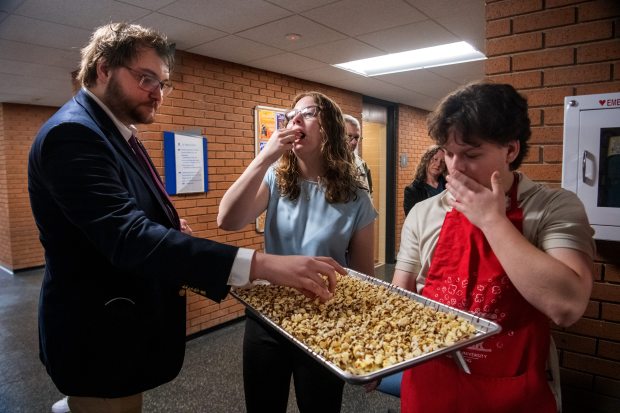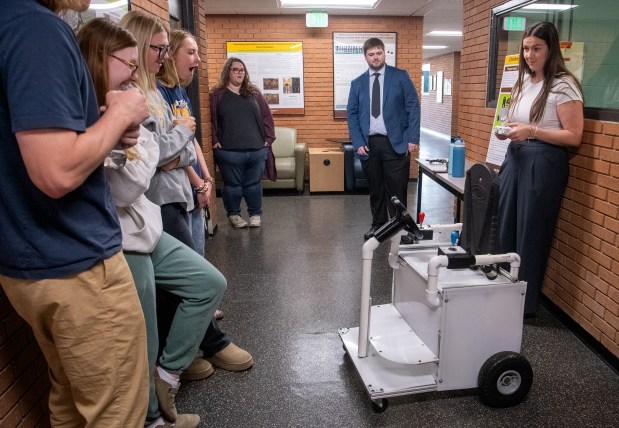While there is joy in creating, there might be even greater joy in creating something that works for its intended purpose, as evident by the cheering Saturday morning of the team of Valparaiso University engineering students when they realized the chocolate drizzling machine they designed and built at the behest of Opportunity Enterprises could get the job done.
The project, along with 16 others, were on display at VU’s annual Design Expo held at the Gellersen Center to show off the year-long project all senior engineering students must complete for their Senior Design Class. In the first semester, the students are divided into teams, given a challenge, and tasked with coming up with a plan. The second semester they build their creation.
“It’s doing what it’s supposed to do!” raved senior mechanical engineering major Tommy Sztuba, who looked a bit shocked in his red apron that they’d pulled it off. Fellow team member and senior mechanical engineering major Peter Mueller said it was the first time they’d run the machine through its paces.
“This is our first big project,” said senior electrical engineering major Trevor Misoh. “On the electrical side of things I’ve learned a lot,” such as working with programmable logic controllers. “It’s basically the brains of the system.”
VU offers a variety of engineering specialties, including aerospace engineering, bioengineering, civil engineering, computer engineering, electrical engineering, environmental engineering, and mechanical engineering.
Rob Schickel, adjunct instructor in civil and environmental engineering, said the project requires a range of skills from the students, from creating and presenting technical reports to developing soft skills.
“They’re learning how to start from zero,” he said. “How do you talk to someone who doesn’t know anything about engineering or plans?”
Also important to engineers is keeping the end-user in mind. Lowell resident Garet Sencaj, the user of a myoelectric prosthetic hand, has been involved with the bioengineering department for years. He lost his hand and part of his forearm in a farming accident in 2012.

“I’ve taken part with the students in a couple classes. I’ve taken part with camps and given my input,” he said. Sencaj finds it heartening to see students interested in furthering the field of prosthetics. “They’ve really advanced a lot in the 10 years that I’ve had it,” he said of his eighth prosthetic hand in a decade.
He’s gone through so many because he says he’s hard on them and has also given some away to people in need and the university for study. Just the hand runs $40,000, while the socket it snaps into and the electrons that go with it are another $40,000.
Sencaj left farming but has a new career as a heavy equipment operator. Students like senior biomedical engineering major Whitney Wollin are working to keep the advancements coming for Sencaj’s next prosthesis.
She was part of the team that built a prosthesis that can be operated through a figure-9 harness. “When I extend my arm the back will open,” she said, demonstrating with the harness strapped to her torso, “and when I relax it will close.”

A force amplification system can be turned on to allow a load cell to record the force in the main cable “so when I apply force the servo motor begins to rotate so I don’t have to put as much force into it as when I was using the body system,” Wollin explained.
She’s been interested in bioengineering ever since she saw a movie when she was a little girl that involved the creation of a prosthetic fin for a dolphin. This summer she’s headed off to an internship with Cook Medical in Bloomington.
She’s hoping it will lead to a career in prosthetics helping more people like Sencaj. “This would be the dream, I would say, for sure,” she said, looking down and flexing the prosthetic hand.
Shelley Jones is a freelance reporter for the Post-Tribune.




